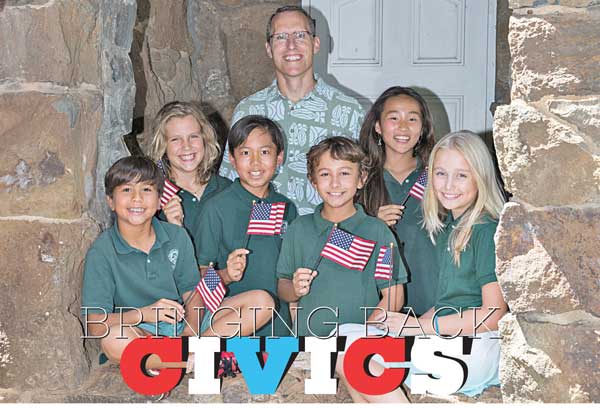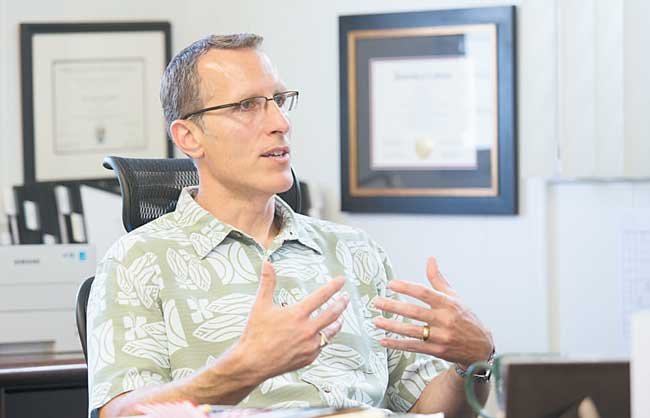Bringing Back Civics
Mid-Pacific Institute’s Paul Turnbull believes learning how government works is important for schoolchildren.
For all appearances, Paul Turnbull was living the good life in Santa Barbara. The president of Mid- Pacific Institute and wife Leslie had three healthy children, a large group of friends and were involved in numerous community projects. Still, something was missing. No matter how many service clubs he joined, without United States citizenship and the corresponding right to vote, Turnbull felt left out.
Learning how government works is important to the Canadian-born educator. U.S. history is mandatory in the Canadian education system, and those early lessons helped Turnbull when he began the process to becoming a U.S. citizen.
Civics, as a host of educators have pointed out, is critical in the development of an informed citizenry, especially for those born outside of the U.S. With Hawaii’s large immigrant population, such lessons take on greater meaning.
052015_MW_cover2.jpg
A 2007 study of 491 school districts by the Center on Education Policy found that over a five-year period, 36 percent of departments surveyed decreased the allotted time for social studies by an average of 76 minutes per week. The time allotted to students in Hawaii is difficult to track.
The state Department of Education determines which classes are necessary for graduation, but the individual schools determine how much class time is allocated to each subject. One thing seems certain among educators: Coupled with budget cuts, No Child Left Behind (NCLB), signed into law by President George W. Bush in 2001, has led to a reduction in the number of hours spent on social studies, art, physical fitness and even science.
NCLB required states that receive federal funding give standardized tests to all students, with a focus on reading, language arts, math and science. The target was 100 percent proficiency in math and reading by 2014.
“As the high-stakes testing increased in its depth, what I ended up seeing was a pulling back of the total number of minutes for arts and music,” says Turnbull, who began his administrative career in the Santa Barbara public school system. “History started to suffer, science started to suffer, which is a real shame. You start pulling back on any of those things and you’retearing away at the fabric of what a comprehensive, well-rounded education looks like.”
A lack of civics knowledge, highly edited, makes for great late-night talk show fodder, but it’s hardly a laughing matter when just one in three eligible voters takes part in national elections.
According to University of Florida’s United States Election process study, just 35.9 percent of eligible voters cast ballots during the 2014 midterm elections. This was the lowest midterm election numbers since 1942, when only 33.9 percent of eligible voters participated. Hawaii didn’t fare much better, with 36.5 percent of eligible voters participating in 2014.
In September 2011, U.S. Department of Education began offering states the opportunity to request a waiver from some aspects of the Elementary and Secondary Education Act, which was passed in 1965 and amended by NCLB. So far, 42 states have received a waiver. Hawaii submitted its waiver request in September 2012, and was granted permission to implement its own system (Strive HI) eight months later. Last year, Hawaii DOE was granted an extension after reaching the highest level: “meets expectations.”
Strive HI replaced many of NCLB’s requirements, focusing not just on testing, but also in areas of concern, like chronic absenteeism, high school graduation rates, college enrollment, standardized tests in math, reading and science, and the achievement gap between highneed students and other students. Unlike Hawaii Common Core (HCC), which was created in 2010 and sets the standards for how children are educated, Strive HI measures and supports those standards. Common Core was created by state education chiefs and the governors of 48 states to create uniform educations in an effort to raise proficiency and eliminate achievement gaps.
“We like to call it an academic checkup of the school,” says DOE spokesman Alex Da Silva. “It’s like when you go to the doctor. Your heartbeat is good, but you’re having trouble breathing, so they address that area. It’s the same way with schools. We look at all these measures and we provide target support in those areas.”







